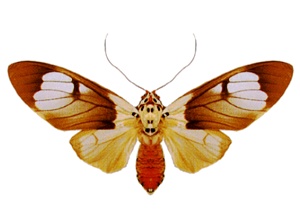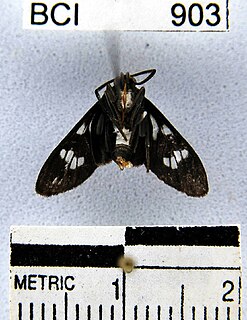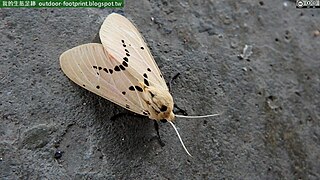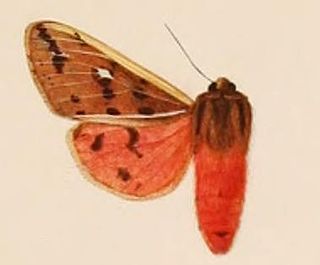Related Research Articles

Utetheisa is a genus of tiger moths in the family Erebidae. The genus was first described by Jacob Hübner in 1819.

Amerila is a genus of moths in the subfamily Arctiinae. A number of species in this genus have a special defence mechanism when they are in their adult stage. When disturbed, they exude a frothy yellow fluid from glands beside the eyes, while making a sizzling noise to ward off their attacker. Similar behaviour has been observed in fertilised females of the North-American moth Utetheisa ornatrix.
Eyralpenus is a genus of tiger moths in the family Erebidae. The genus was erected by Arthur Gardiner Butler in 1875. The moths in the genus are found in the Afrotropics.

Heliura is a genus of moths in the subfamily Arctiinae. The genus was erected by Arthur Gardiner Butler in 1876.
Hyalaethea is a genus of moths in the subfamily Arctiinae. The genus was erected by Arthur Gardiner Butler in 1887.
Hyaleucerea is a genus of moths in the subfamily Arctiinae. The genus was erected by Arthur Gardiner Butler in 1875.

Lophocampa is a genus of moths in the family Erebidae. The genus was erected by Thaddeus William Harris in 1841. It contains around 75 species.
Monosyntaxis is a genus of moths in the family Erebidae. The genus was erected by Swinhoe in 1901.
Paracles is a genus of moths in the subfamily Arctiinae. The genus was described by Francis Walker in 1855. The species range from Panama to Patagonia, with quite a few in the southern temperate region of South America.
Scoliosia is a monotypic moth genus in the subfamily Arctiinae erected by George Hampson in 1914. Its single species, Scoliosia brunnescens, was first described by Walter Rothschild in 1912. It is found in Papua and Papua New Guinea.
Sphecosoma is a genus of moths in the subfamily Arctiinae. The genus was erected by Arthur Gardiner Butler in 1876.

Spilarctia is a genus of moths in the family Erebidae. The genus was erected by Arthur Gardiner Butler in 1875.

Spilosoma is a genus of moths in the family Erebidae originally described by John Curtis in 1825. A very heterogeneous group, it is in need of review by the scientific community, as certain species probably need reclassification into their own genera.
Striosia is a monotypic moth genus in the subfamily Arctiinae erected by George Hampson in 1914. Its single species, Striosia irrorata, was first described by Rothschild in 1912. It is found in New Guinea, where it is known from Papua and Papua New Guinea.
Teracotona is a genus of moths in the family Erebidae from the Afrotropics. The genus was erected by Arthur Gardiner Butler in 1878.

Trichromia is a genus of moths in the family Erebidae erected by Jacob Hübner in 1819. The members of this genus are largely indigenous to South America.

Spilaethalida turbida is a moth of the family Erebidae first described by Arthur Gardiner Butler in 1882.

Amerila astreus is a moth of subfamily Arctiinae described by Dru Drury in 1773. It is found from the Oriental region to New Guinea. The species is found in primary and secondary habitats ranging from lowlands to montane regions.
Papuasyntaxis is a monotypic moth genus in the family Erebidae erected by Rob de Vos in 2009. Its only species, Papuasyntaxis metallescens, was first described by Walter Rothschild in 1912. It is known only from central Papua Indonesia; however, it is probably also present in the central western part of Papua New Guinea.
Trichaeta aurantiobasis is a moth in the subfamily Arctiinae. It was described by Walter Rothschild in 1910. It is found in Papua, Indonesia, where it is only known from Fakfak.
References
- de Vos, R., 2011: Nicetosoma gen.nov., a new genus for the "Spilosoma" niceta group of species East of the Weber Line (Lepidoptera: Erebidae, Arctiinae, Arctiini). Suara Serangga Papua5 (4): 109-144.
| This Spilosomina-related article is a stub. You can help Wikipedia by expanding it. |